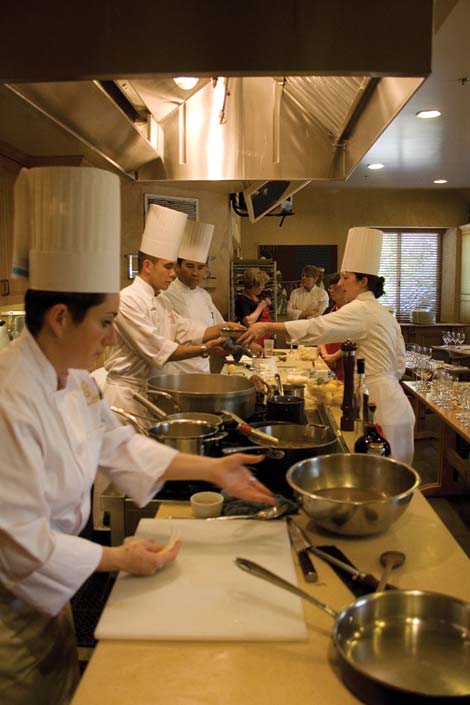
Ryan lely/Sonoma Valley Sun

The aroma of something delicious cooking greets visitors entering Ramekins and wafts through the corridors, drawing them towards the source. From behind the kitchen doors, the murmur of happy voices emanates, rising to a buzz as the doors open to reveal a roomful of aproned cooks busy dicing, blanching, pureeing and sautéing under the watchful guidance of a teaching staff of professional chefs.
This scene has been repeated innumerable times since Ramekins began operations in 1998, offering cooking classes and chef demonstration lectures. Over the years some of the best-known chefs in the world — including Jacques Pepin, Traci Des Jardins, Michael Chiarello, Thomas Keller, Diana Kennedy and Martin Yan — have shared their techniques with classes of culinary enthusiasts.
Ramekins arose through the efforts of a group attempting to woo the Culinary Institute of America into establishing its West Coast facility in Sonoma. Suzanne Brangham was part of that group, so when the CIA decided to locate in St. Helena, she saw an opportunity for Sonoma to create a scaled-down version of the concept. “There was a lot of excitement about finding a way to present Sonoma’s great produce, chefs and wine,” said Brangham, who at the time was a builder and developer, as well as owner of The General’s Daughter restaurant. “We had done a lot of research on facilities around the country and I took the best ideas and incorporated them into a design for a cooking school with a bed and breakfast inn and an event space.”
The handsome facility is a rammed earth building, an ancient technique Brangham applied to Ramekins to create two-foot-thick walls and a vaulted, trussed wood beam ceiling. The two kitchens provide a setting for chef demonstrations with seating for 36, and a full restaurant kitchen for hands-on classes. A large event room is used for celebrity chef presentations, rehearsal dinners and private events. It opens to an expansive stone tile garden patio with an herb and flower garden. An addition is the grilling garden with its armada of barbeques, grills and a wood-fired oven. A whimsical asparagus-shaped staircase leads up to the second floor inn with six luxury suites plus a breakfast and lounge area. Original art reflecting food-related themes is everywhere..
Though Brangham built and owns Ramekins, she leaves the administration of the school and inn to general manager and culinary director Lisa Lavagetto, who took over that position from Bob Nemerovski, under whose leadership Ramekins was named 2005 “Cooking School of the Year” by the International Association of Culinary Professionals. Sharing the managerial duties is catalog editor, author and chef liaison Yvette Preute (culinary staff manager Mary Karlin is on leave, writing a book). Lavagetto has been with Ramekins since the beginning; she and Preute both switch roles as needed. “We’re all ‘multi-functional’ here,” said Lavagetto, a self-taught chef who also conducts classes. Preute often acts as the kitchen manager, overseeing all the details for classes that include guest chef demonstration classes, hands-on courses, intimate chef’s tables, winemaker dinners and private team-building classes.
In a recent team-building class in the commercial kitchen, a corporate group spent the evening preparing a dinner menu. “The CEO works side-by-side with the guy from the mailroom,” said Preute. “It’s a great ‘leveling’ experience and it’s a positive, fun-filled time.” A cadre of volunteers assist the “students,” and professional chefs guide them, answering questions and offering tips and techniques.
In the demonstration kitchen, Jesse Llapitan, executive chef at the Palace Hotel in San Francisco, and his team took the class through a six-course meal, replete with lively interaction. Llapitan’s courses were each paired with wine, as a winery representative explained the nuances of each. Preute, along with her colleagues, plans the schedule and books the guest chefs. Topics range from dim sum and Mexican seafood to trendy 30-minute meals and great grilling techniques.
Participants are a mix of locals and people who come from around the world, according to Preute. “People are passionately interested in fresh, local food, and entranced with the wine country lifestyle, so we design our classes to take advantage of the best seasonal produce prepared by chefs who excel in blending the flavors of the region in unique and innovative ways.”
Lavagetto, speaking as a chef and general manager said, “Sonoma, with its Mediterranean climate and year-round availability of sustainably grown fruits and vegetables and humanely raised meat and poultry, represents a unique experience for visitors. We teach them to use the best ingredients, to trust their instincts when it comes to taste and to have a great time in the kitchen.”
Ironically, the one person who is not in the kitchen is Suzanne Brangham. “I don’t cook,” she said. “I gave it up when my son was grown and I was too busy as a contractor and developer to prepare meals. Now I enjoy the wonderful dishes that others create.” Given what she has served up for all foodies to enjoy, there’s no question that she’s made a major contribution to Sonoma’s culinary reputation, even if she did it with a hammer, not a spatula.
Ramekins Sonoma Valley Culinary School
450 W. Spain St., Sonoma; 707.933.0450;
www.ramekins.com




